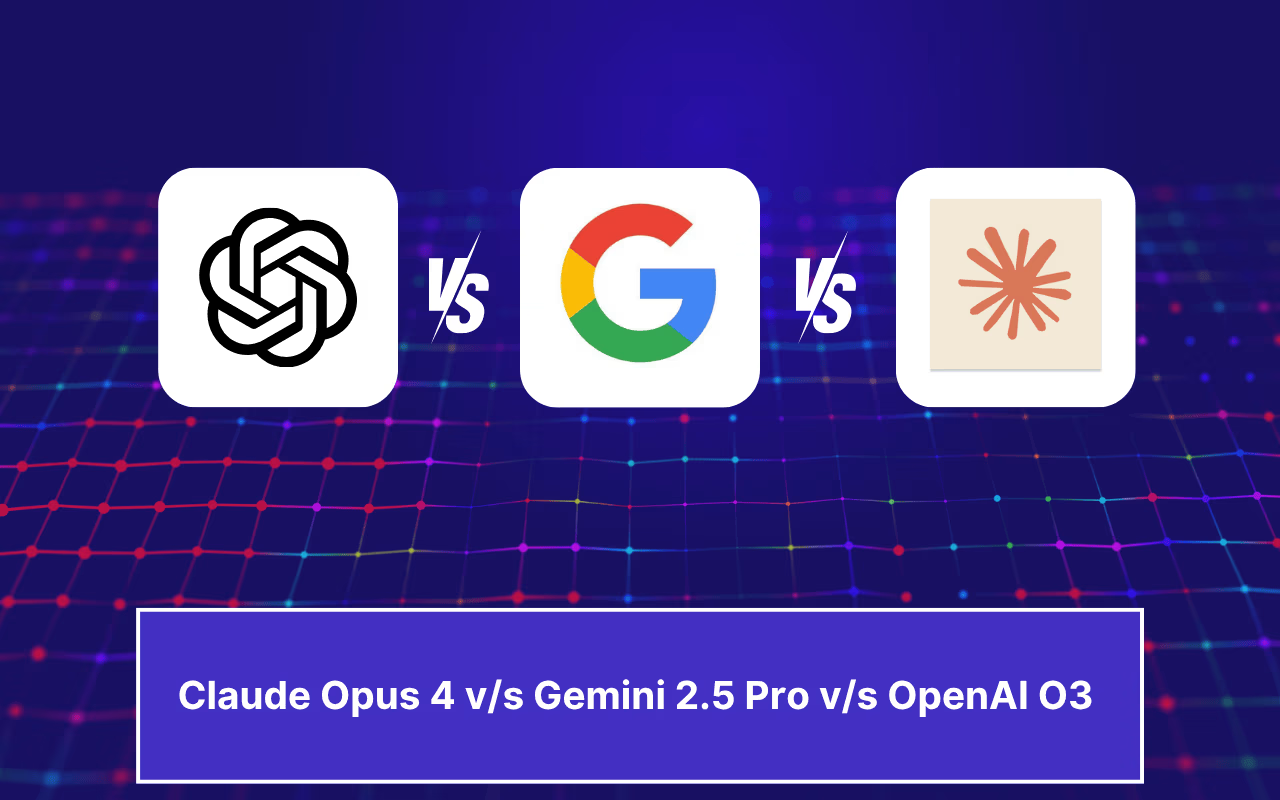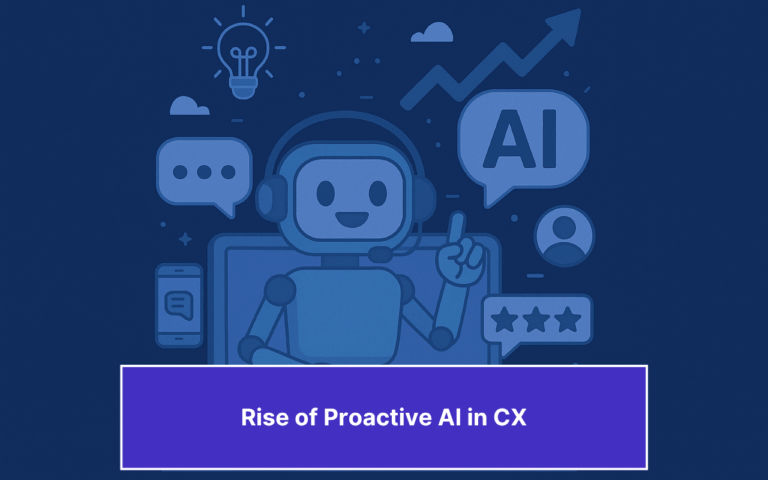Updated on March 26, 2025
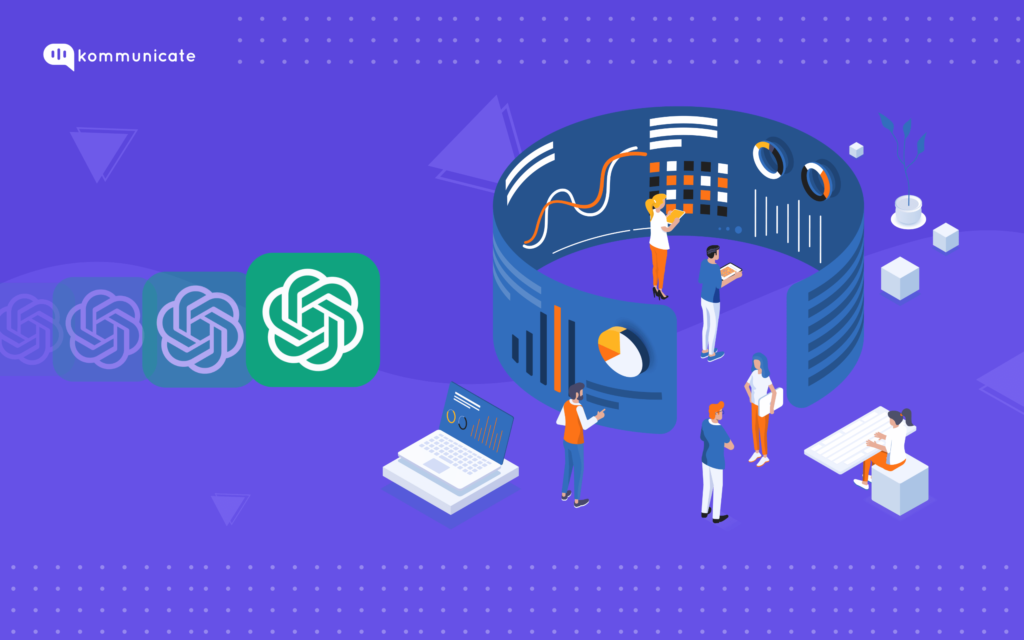
November 30, 2022 – OpenAI releases ChatGPT to the world.
December 4, 2022 – ChatGPT touches 1 million users, making it the fastest growing internet application of all time.
January 23, 2023 – Microsoft announces that it is investing $10 billion in OpenAI.
February 6, 2023 – Google unveils Google Bard, to compete with ChatGPT.
As you can see, the AI race is surely heating up with each passing day, and we have more and more use cases emerging with it. Enterprises are also taking notice, and OpenAI is soon set to launch an enterprise version of ChatGPT.
- If you are an enterprise, how can you benefit from ChatGPT?
- What are the use cases?
- What are the challenges of implementing ChatGPT?
We take a look at all these and much more in this blog post.
Let’s begin where it all began.

Enterprises and ChatGPT
Enterprises are increasingly using ChatGPT to perform a wide variety of tasks, including automating customer service, generating leads and providing product information. By the year 2033, the chatbot market will touch a whopping $4.9 billion, according to this report.
How does ChatGPT work
Before we delve into how enterprises can use ChatGPT to their advantage, let’s take a quick look at how ChatGPT works. The underlying technology behind ChatGPT consists of two techniques – pre-training and inference.
Pre-training:
Pre-training is the first step in training LLMs like ChatGPT. In this step, the model learns to predict the next word in a sentence, using a large corpus of data. This training happens in two ways – supervised and unsupervised. Supervised learning involves training the bot on what is called labeled data, with corresponding inputs and outputs.
Supervised learning vs Unsupervised Learning
But supervised learning fails in complex cases. Supervised learning requires labeled data, which is time-consuming to create. What we mean with labeled data is data that is manually updated with a corresponding output. For instance, a large dataset of questions and answers, which are readily available.
This is why LLM training occurs on unlabeled data. Unlabeled data allows LLMs to learn the statistical relationships between words and then reproduce the correct output.
Unsupervised learning involves training the LLM on a vast trove of unlabeled data. For instance, a chatbot training can occur on a vast set of books, websites and articles. The model would then try and learn the patterns such as order of words in a sentence, relationship between words, meanings of phrases etc. Finally, the model would now be in a position to reproduce text in a format similar to which its training was done.
Transformers – revolutionizing the way NLP is moving forward
Training LLMs used to be a humongous task, but all that changed with Transformers. After the introduction of transformers in 2017 by Google AI, there was a revolution in LLM training.
Transformers attend to different parts of a sentence, which allows them to understand the relationship between words and phrases. This allows them to generate text that is coherent and grammatically correct.
Transformers will one day change the way we interact with computers, and are one of the most exciting fields of study in the realm of Artificial Intelligence. Transformers consist of multiple layers, which itself consists of sub-layers.
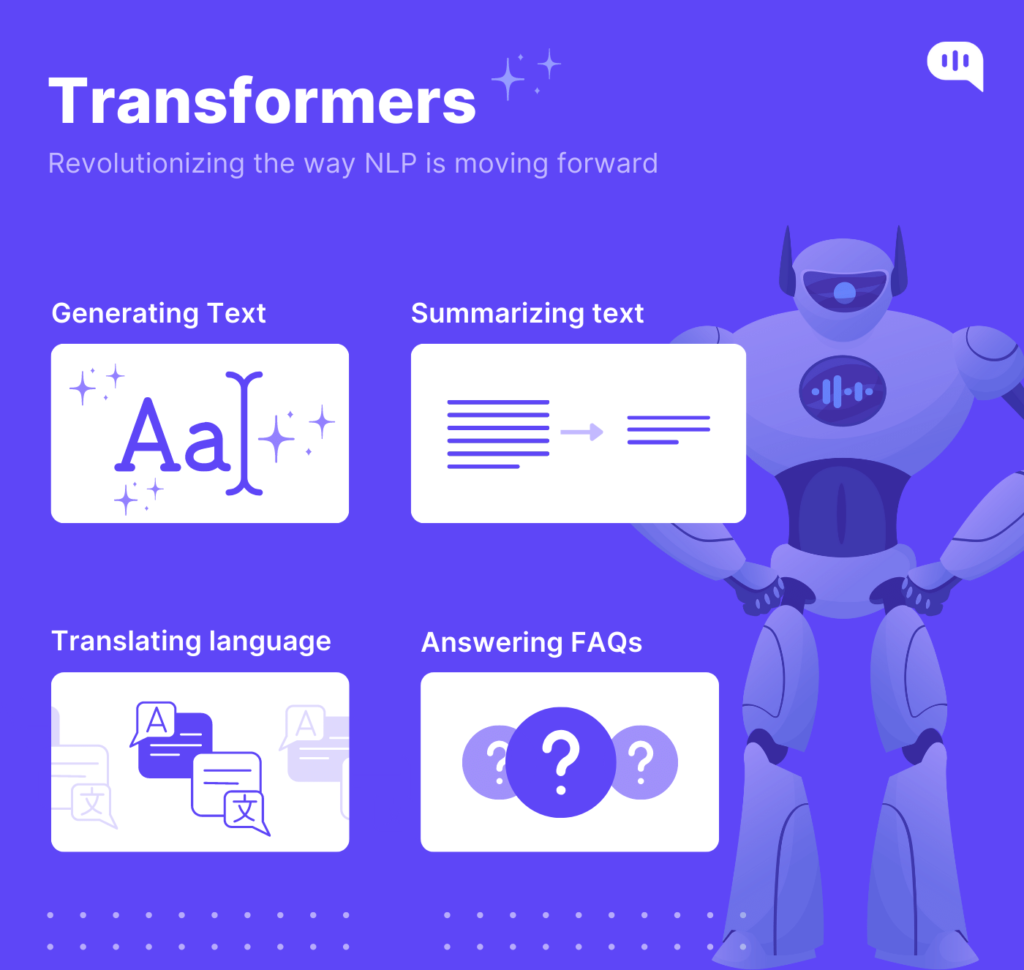
While training, the transformer is given input data in the form of a sentence. It must then predict what the next words will be based on the input data. As you feed more data into the transformer, it learns to predict the next sequence, and continues to do it iteratively.
The LLM gets more and more accurate over time, and makes such a high degree of accurate predictions that it becomes indistinguishable to separate it from human writing.
We now have a basic understanding of how ChatGPT works. Let us now see how enterprises are increasingly using AI chatbots.
Automate customer queries, streamline support workflows, and boost efficiency with AI-driven email ticketing from Kommunicate!Why are more and more Enterprises adopting AI chatbots
A. Chatbots help in improving customer support:
Customer support forms the pillar for the success of any product. But this can be a challenging task in case you have limited resources, since every customer to your business expects personalized support.
This is where AI chatbots can step in. AI chatbots can provide 24/7 support and answer simple customer queries, while at the same time also helping solve customer issues. They can attend to every customer uniformly, irrespective of the customer’s size or the time of the day they reach out.
AI chatbots can collect feedback from customers, which you can then use to improve your product.
For Product managers:
- Resolving simple issues: Enterprises can use AI chatbots to resolve issues such as resetting passwords or updating account details. Customer support agents no longer have to worry about these tickets, and they can then focus on providing better service.
- Collect customer feedback: AI chatbots can collect customer feedback. This feedback will help product managers identify the gaps in the product, while ensuring that the product meets the demand of the customers.
- Answer FAQs: Questions such as “How do I use my product?” or “How do I apply for a refund?” can be given to an AI chatbot, which leaves time for product managers to focus on solving more complex problems.
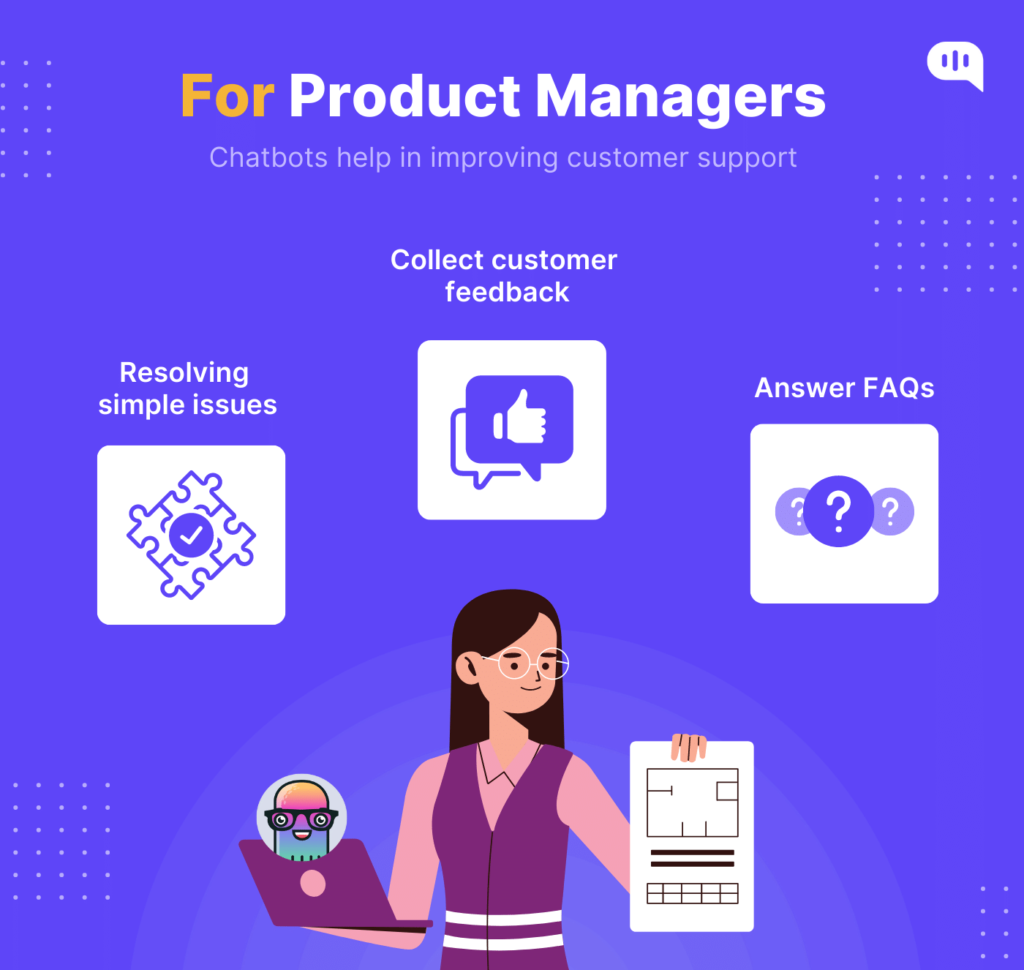
B. Chatbots help in personalizing customer interactions
According to this McKinsey report, companies that work on their personalization generate 40 percent more revenue when compared to other players. Personalization indicates to customers that you actually care for them, and a tailored experience will lead to customer loyalty.
Enterprises can use AI chatbots to provide personalized interactions. Better customer experience, reduced costs, and increased revenue are all by-products of providing personalization
For Product managers:
- Create personalized profiles: Product managers can use AI Chatbots creatively by training them on a plethora of customer data available with them. This data includes browsing history, website activity and social media posts. The chatbot can use all this data to tailor its interactions with the customer.
- Using chatbots as self-serve agents: Product managers can deploy AI chatbots as self-serve agents, resolving their issues without the need for human intervention.
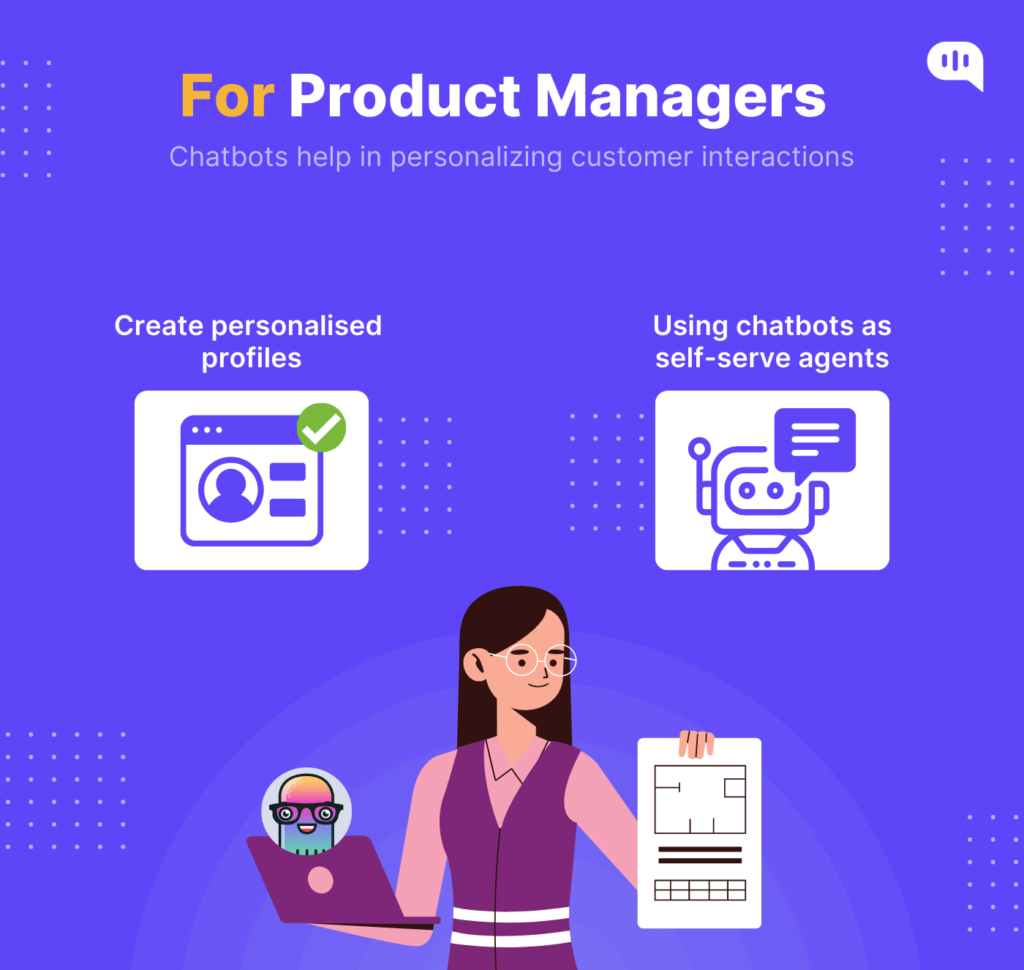
C. AI chatbots help in Task Automation
Automation saves time, and, in business, time is money. AI chatbots can help automate a lot of tasks, such as answering customer queries and collecting feedback.
For Product managers:
- Save Time: Automation saves a lot of time for PMs, who can then use it for a better purpose – like building a solid GTM strategy.
- Minimize errors: Human beings are prone to errors, which may creep into our customer communication and leave customers with a bad taste. Automation helps eliminate such errors.
- Improve the quality of customer service: Customers today are looking for quick solutions, and an AI chatbot can help deliver this. Accurate and fast responses are the hallmark of great customer service, and a chatbot helps achieve this.
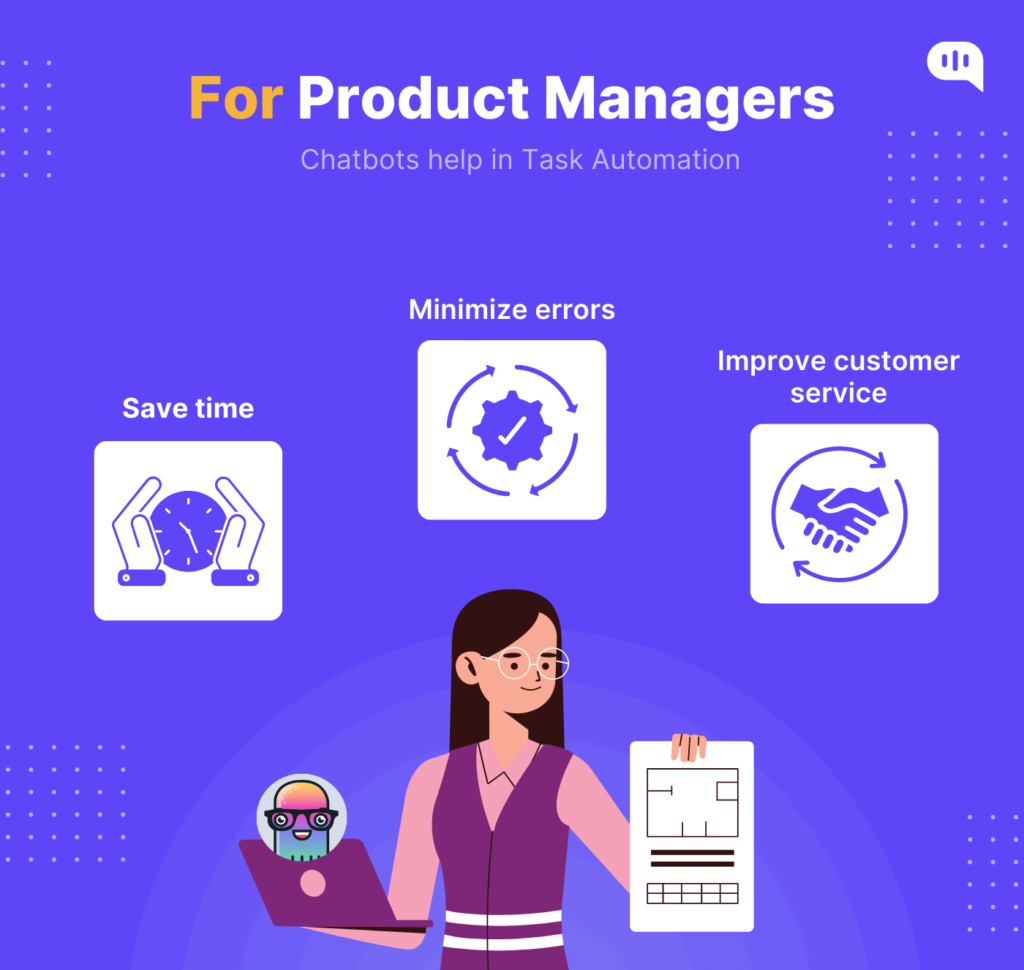
D. AI Chatbots help answering FAQs
FAQs are one of the most visited sections on a website. To let you in on a little secret, it is said that Google even favors websites that have an FAQ section when someone conducts a search. But your customer support agents are humans, and answering FAQs is repetitive and boring.
This is where an AI chatbot comes into the picture. Enterprises can program chatbots to answer FAQs. We here at Kommunicate have taken this one step further and bring to you the Document Scanner, where you can upload your FAQs in the form of a PDF and our AI chatbot will start answering the questions in the document.
For product managers:
- Answer common questions: Common questions can be relegated to the chatbot, and PMs can focus on more complex tasks.
- Round the clock availability: AI powered chatbots are available 24/7, and PMs need not work past their shifts to make sure that all the customer queries are answered.
- Greater personalization: AI Chatbots have access to a large amount of customer data. Chatbots can use this data to personalize responses to customers, freeing up PMs time.
So we now know why AI chatbots are growing in importance. But what are the specific use cases for ChatGPT, especially in an enterprise setting.
Let us take a look now.

Use cases of ChatGPT for Enterprises:
1. Marketing content creation:
Creating content is hard, ask any Content Writer or video producer. ChatGPT is revolutionizing this space with the chatbot ready to spin out entire blogs, video scripts, infographics and social media updates in a matter of seconds.
ChatGPT is thus democratizing the content creation space, and you no longer have to be an expert on a topic to churn out content around it. And it’s not just blog posts. We took ChatGPT for a spin and asked it to write a social media update, and this is what the AI produced.
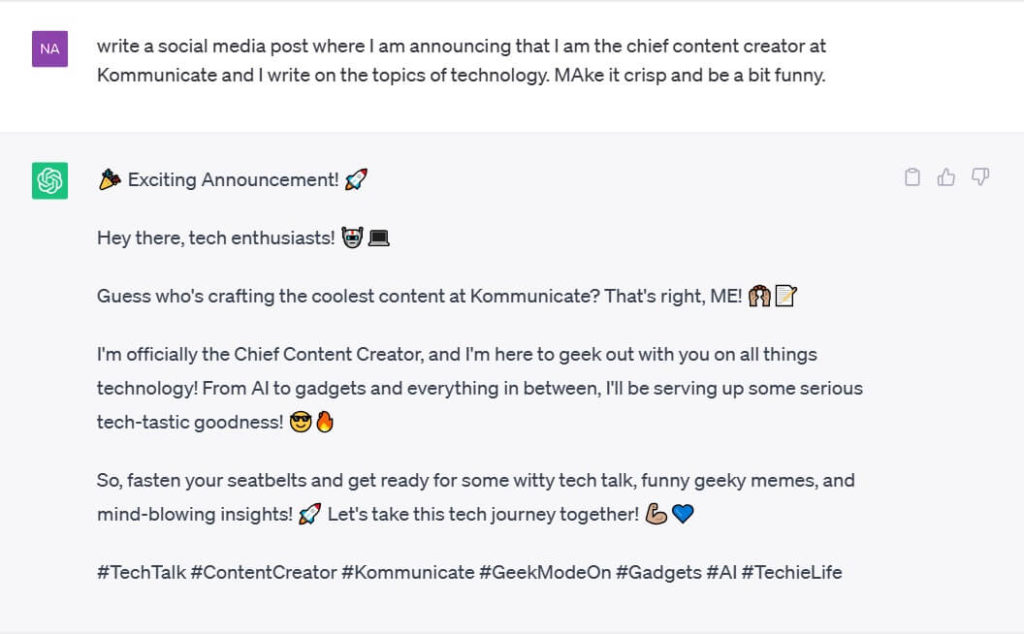
Social media posts are one thing, but how does ChatGPT fare when writing an actual blog post that ranks on Google? This is a challenge that all bloggers face, and we are now putting ChatGPT to the test with an actual blog post.
“How to write a blog post that ranks on Google SERPs?” is a blog post that is the Holy Grail for all bloggers, and is a severely competitive keyword. ChatGPT made a good attempt at writing the post, and the results were impressive, to say the least.
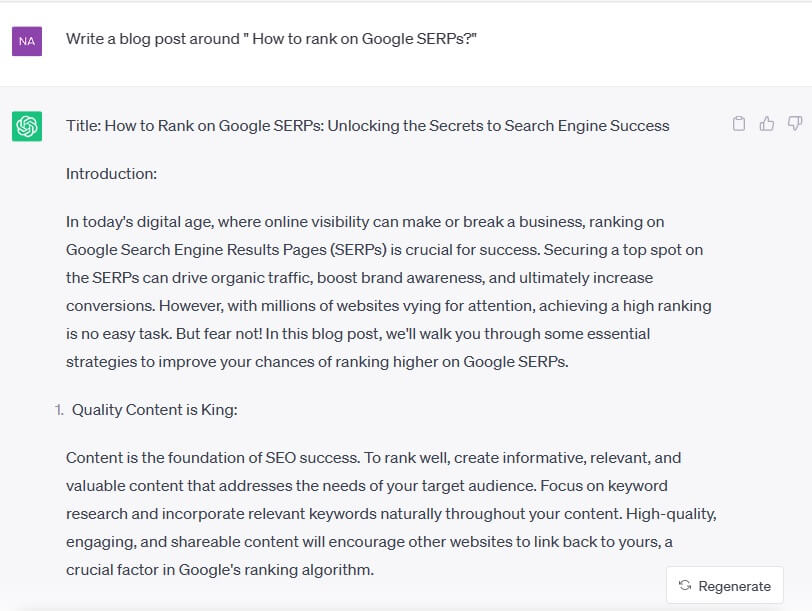
Enterprises now can churn out blog posts at a pace that is unprecedented, using just a few smart prompts and not actually having to do the heavy lifting of writing lengthy posts.
A word of caution, though. Google has been known to penalize content written by ChatGPT and other AI tools, so you have to use the tool wisely.
2. Providing Programming assistance
ChatGPT can write code, and when the LLM started catching fire on the internet, there was a lot of speculation that it was the end of Programming jobs as we know it.
Videos like this one started popping up on Youtube.

While the debate still rages on if ChatGPT is a job taker, what we can safely say is that it makes the life of programmers that much simpler.
ChatGPT has been trained on a large amount of data, including source code written in various programming languages. ChatGPT can summarize code, and after identifying key components of the code, provide an explanation in natural language.
We don’t like to take things at face value, so what we did was take a piece of Python code and ask ChatGPT to explain it.
We wrote a code in Python, to generate the Fibonacci series, and ensured that there is no mention of the word “Fibonacci” in it.
This was the prompt that we used.

We then went ahead and asked ChatGPT to explain this code to us.
The results? Well, see for yourself.
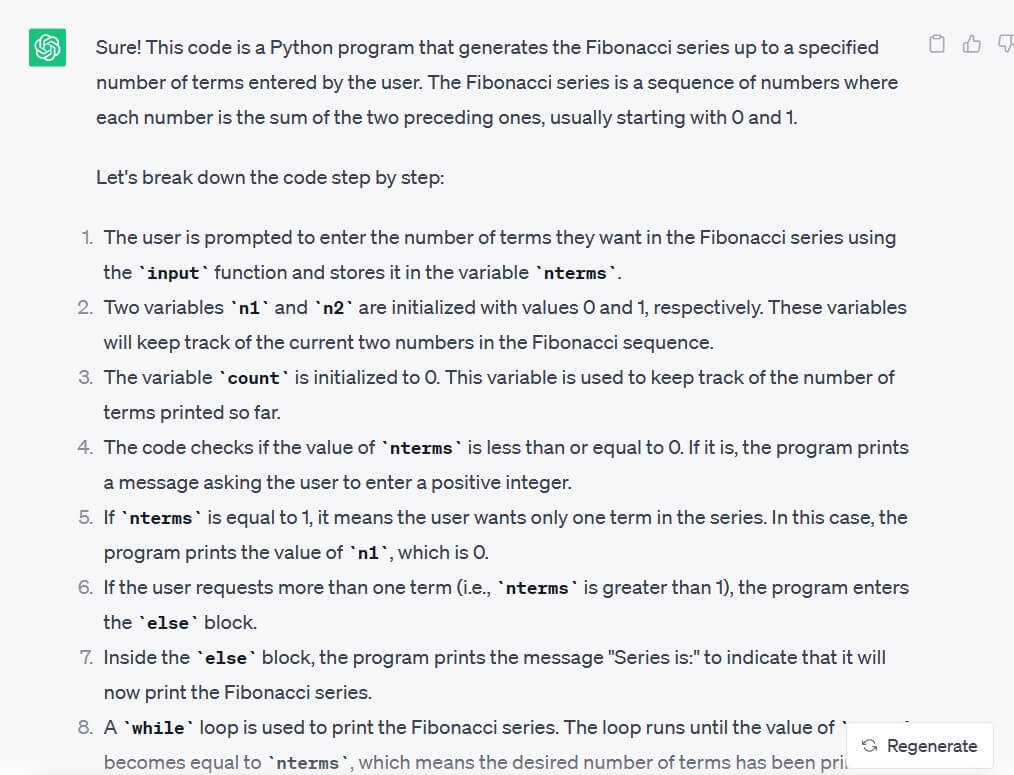
ChatGPT recognized that the code was written in Python, and then went ahead to explain the steps in detail. With its natural language generation capability, ChatGPT provides examples or analogies which give you an explanation of the code’s functionality.
And it’s not just explaining code. ChatGPT can compress code and also fix code which has syntax errors. It can act as a powerful programming assistant, and help programmers do their jobs much faster.
3. Knowledge Base integration
ChatGPT is a really powerful tool, this much we have established. Another powerful application of ChatGPT is using it for knowledge base integration. We have already told you about the document scanner, where we at Kommunicate used the underlying technology behind ChatGPT to scrape an entire document.
You can then train the chatbot on the document available to it, and the chatbot starts answering questions based on this document. Another use case for ChatGPT is website scraping. ChatGPT scrapes your entire website and starts answering questions for which the answer is available, say, in your FAQs or documents section.
For Product Managers:
- Accurate responses: As a PM, you can train your chatbot to give quick and effective responses using ChatGPT by training it on your document.
- Relevant and up-to-date information: ChatGPT can provide relevant information to customers, based on their past interactions with your organization.
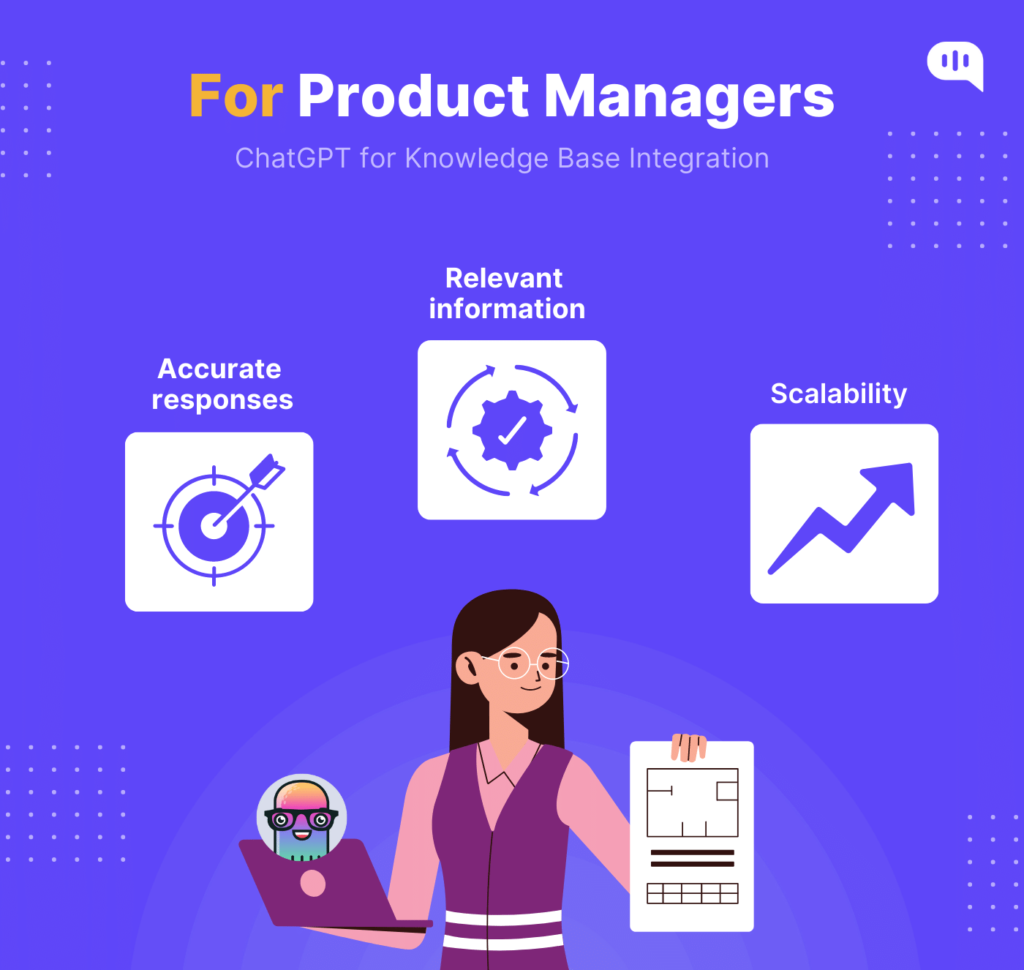
- Scalability: You can scale ChatGPT so that it meets the needs of a large enterprise.
4. Product recommendation
To use ChatGPT as a product recommendation engine, you will need to follow the following process.
- Gather data: We mean a lot of data, which includes a customer’s past purchases and browsing history.
- Train ChatGPT: In this step, you need to train ChatGPT so that it can learn to identify patterns and make recommendations.
- Integrate ChatGPT: In the final step, you need to integrate ChatGPT with the product’s app or website. The chatbot will then give customer recommendations in real time.
ChatGPT can then recommend products across different categories, just like how Amazon does with a product. It may be a product that is on the periphery of the customer’s mind, and when your customer sees it on the “Also frequently purchased” items or “Items bought along with this..”, they are more likely than not to hit the purchase button.

ChatGPT can also give a recommendation based on a variety of factors, such as availability, price and customer reviews. As time progresses, you can use ChatGPT to track customer engagement with product recommendations.
5. Copywriting
Content creation in the form of blog posts and social media is one thing, but copywriting is a whole different ball game. Copywriting requires you to understand the minor nuances of the language, and writers spend years trying to hone their copywriting skills.
All that changes with ChatGPT. Here are a few areas of copywriting that ChatGPT can greatly augment real writers.
- Generation of ideas: Copywriters spend most of their time staring at a blank page, hoping the words come through the keyboard to the screen. ChatGPT can be of immense help here, helping generate ideas quickly, and providing suggestions for headlines and body content. This will help copywriters overcome the dreaded “writer’s block.”
- SEO: ChatGPT can help copywriters optimize their content for Search engines, by giving them suggestions on relevant keywords. ChatGPT can also give suggestions on topics and how to address the target audience. As Maria Harutyunyan, CEO and Head of SEO at Loopex Digital, puts it: ‘Leveraging AI tools like ChatGPT alongside expert SEO strategies helps streamline the content creation process, ensuring it resonates with both search engines and the audience.'”
- A/B testing: ChatGPT can be used to A/B test a lot of copywriting campaigns. A simple prompt will give you multiple variations of the same campaign. You can then go ahead and test the effectiveness of each campaign individually.
We put ChatGPT to a Copywriting test, and we quite liked what we saw. ChatGPT gave us multiple options, with catchy headlines that we could then experiment with.
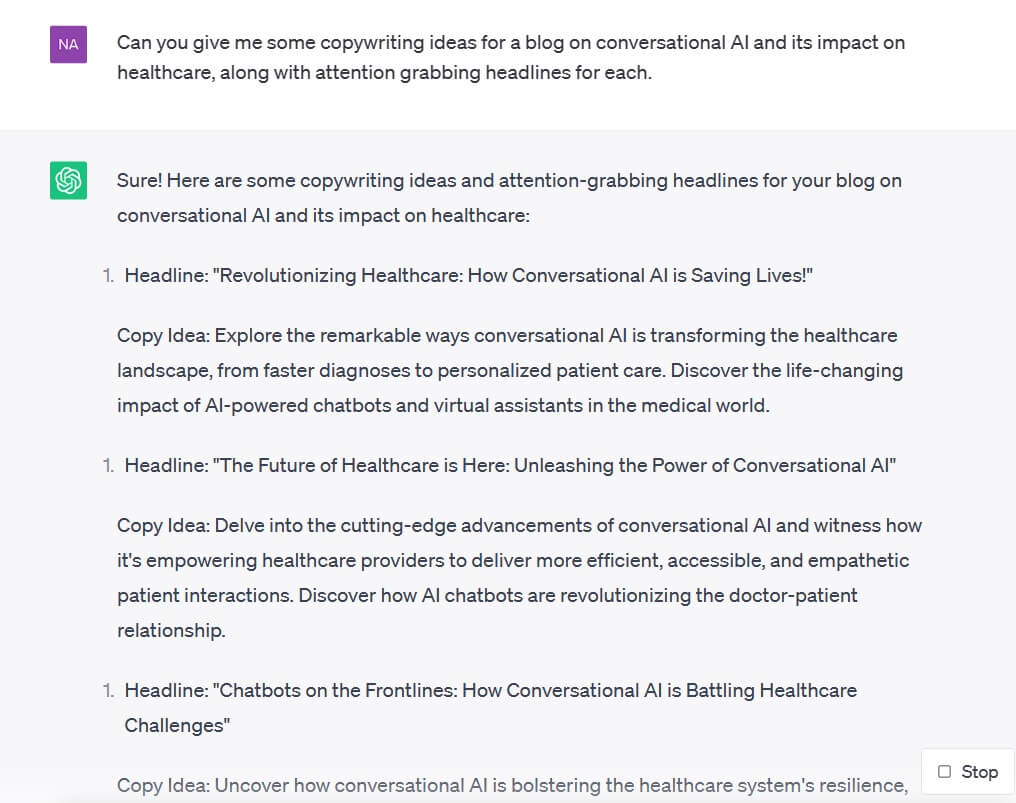
6. Employee onboarding and training
Employee onboarding and training is a resource intensive activity for enterprises, who want to onboard productive resources in the least amount of time. ChatGPT can help in this regard by automating a lot of processes.
Some of the ways ChatGPT can help enterprises in employee onboarding are:
- Personalized onboarding checklist: ChatGPT can personalize the onboarding checklist of each new employee. This onboarding checklist can include items such as setting up their company mail and accessing company resources.
- Employee queries: You can use a ChatGPT powered bot to answer employee queries around issues such as company policies and procedures.
- Training materials: Companies can use ChatGPT to dispense training materials on a variety of topics, such as product knowledge, technical skills and customer service.
We have just touched upon the tip of the iceberg when it comes to how enterprises can use ChatGPT. As the days progress, we are sure that there will be more use cases popping up, and ChatGPT becoming an integral part of every enterprise’s arsenal.
There are, however, a few challenges that come with incorporating ChatGPT.
Here is a gist of them.

Challenges in using ChatGPT for Enterprises
- Data privacy and accuracy: ChatGPT’s training occurs on a massive dataset of text and code. You must ensure that this data is sourced correctly so that ChatGPT can generate relevant and accurate responses.
- Prevent bias: ChatGPT training happens on a dataset that may reflect the bias of the people who have created it. This means Enterprises should take extra care to be aware of these biases and stop them from giving irrelevant responses.
- High initial costs: Implementing ChatGPT for your enterprise requires an advanced level of NLP and machine learning principles. This means hiring programmers or third-party vendors who may impact the operating costs of enterprises.
- High maintenance costs: ChatGPT implementation in enterprises may require a lot of computing power, which will add to the maintenance costs. This will again affect the enterprise’s bottom line.
Parting words
Even though there are challenges, ChatGPT is a very powerful tool that enterprises can use to streamline a lot of activities. We have just begun to explore the exciting possibilities of this technology. In today’s competitive market where enterprises adapt or die, tools like ChatGPT can surely make a difference.
As the Head of Growth, Marketing & Sales, Yogesh is a dynamic and results-driven leader with over 10+ years of experience in strategic marketing, sales, and business development.
At Kommunicate, we envision a world-beating customer support solution to empower the new era of customer support. We would love to have you on board to have a first-hand experience of Kommunicate. You can signup here and start delighting your customers right away.


